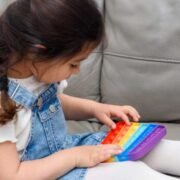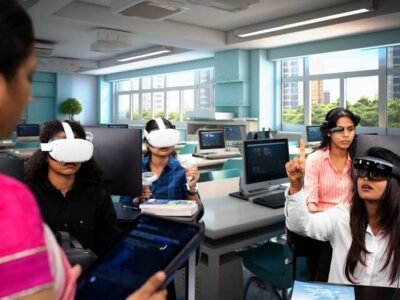As the world becomes a global village with the help of information and communication technology (ICT), technological integration and understanding in real life become ever so critical. Children as young as two years use social media to interact with others over the internet regularly. In that case, ICT is increasingly becoming the global focal point of communication and interactions, dominating the commerce and telecommunication sectors.
Educational entities have not been far behind with the introduction of e-learning in the last few decades and the integration of information technology in teaching. As a result, a pedagogical change is imminent, with most educational forums containing at least one aspect of ICT. As a result, digital literacy is a lifelong skill that students must acquire at an early age.
Digital literacy application in the learning environment and the outside world makes it critical for survival in a highly competitive yet diverse life. Examples of digital literacy in education include discussion forums on social media, online presence, and research publications.
What is Digital Literacy?
Digital literacy implies having the knowledge and skills to communicate, learn, live, and work in a predominantly tech survey society where information access and dissemination are digitized. It is the ability to find, assess, create, and share information through information and communication technology tools. Digitally literate learners can engage with the learning material through everyday activities, expanding their critical thinking skills and creativity. The definition has three primary components, including;
Finding content
Consuming digital content goes beyond ordinary reading or listening. It is an interactive process that allows users to participate in the continuous manipulation of information. Book contents are usually static, with defined boundaries defining themes and comprehension. Finding digital content is more fluid and dynamic, with content in a constant loop of change. A simple text on a webpage could have several other linked content sources that a reader must learn to accommodate or ignore. One must understand how and when to interact with the data presented through a video or blog. Finding information online is faster yet more complicated and detailed.
Creating content
Digital literacy also entails creating content. Learners learn to develop messages, videos, and audio through digital platforms. Creating content online is risky as the audience may be more or less responsive. The creator exposes their knowledge to scrutiny with no opportunity to disengage from the information.
Sharing content
As a result, one must learn the art of curation. Digital users have a unique opportunity to interact with a broader market and bigger population. Hence, the art of selecting the content and organizing it for presentation to a specific audience requires more skills than sending a letter. Digital platforms are more powerful tools than mainstream media, with the potential to revolutionize societies. Hence, sharing involves a bigger responsibility and conscientiousness.
Principles of Digital Literacy
Comprehension
Digital literacy entails the ability to understand content shared through ICT. Understanding goes beyond concrete reasoning to incorporate aspects of utilization of knowledge through interaction. It entails abstract reasoning, where individuals can conceptualize information from various perspectives. Comprehension is critical to digital literacy as it primarily determines the ability to apply the acquired knowledge.
Interdependence
The global world is becoming increasingly interconnected, with various aspects working as one integrated system. As globalization transforms global interaction, ICT dominates communication in all forms, including businesses and education. The interdependence of ICT concepts and platforms necessitates this integration and interconnection. Digitally literate individuals should understand the various points of interdependence and objectively integrate knowledge through different media.
Social factors
Diversity remains an integral component of globalization. ICT integrates various cultures and traditions, allowing people to learn more about and respect others. In that case, digital literacy entails the ability to retain objectivity while interacting with people from varying backgrounds. It is about understanding that various social factors influence the sharing and meaning of the information shared through social platforms. These concepts define digital literacy application by various entities.
Curation
Digitally literate individuals should demonstrate the ability to create, share, and store information. The principle of curation defines the process of selecting, organizing, and presenting digital content to add value to it or society. Digitally survey learners understand the concepts of sharing information online while retaining the knowledge without exposing themselves to manipulation or loss. Curation involves selecting content from a specific area and organizing it for presentation to a predetermined audience.
Need help developing a digital literacy teaching plan? Contact the professional essay writing service CustomWritings with 15+ years of experience in education and academic materials. The company has helped millions of educators and learners globally to improve their skills. While students utilize the service to improve their grades through affordable custom essay templates and research assistance, teachers turn to CustomWritings for personalized lesson plans and quality presentations.
Top 5 Benefits of Digital Literacy in Education
Improves critical thinking
Digital literacy in early childhood education improves critical thinking skills through exposure to information and a challenging environment. Information and communication technology enables learners to overcome various disadvantages of traditional learning, availing resources through various platforms. As a result, students interact with this knowledge and criticize it.
Improving communication skills
One of the primary advantages of digital literacy is skill development. Learners develop their writing, listening, speaking, and reading. These communication skills are essential to the learning process and dictate the absorption, retention, and dissemination of knowledge.
Improving creativity
Digital literacy in higher education improves real-life skills used in other sectors. As students prepare to join the workforce, they develop the necessary abilities to compete with others for scarce resources. Digital literacy enables comprehension of challenges and the development of solutions through creative means.
Enhancing collaboration
Digital literacy enables learners to engage in discussions through various collaboration platforms with peers and educators. These engagements in and out of the classroom expand the learning environment and boost information access.
Enhancing perspective
Digital literacy entails comprehension, the ability to understand information from various perspectives. Learners are exposed to different views about the same topic, allowing them to engage in discussions and data evaluation. The information is also available in various formats and graphics, expanding their ability to develop their knowledge through processes, feelings, and behavior.
Why is Digital Literacy Important in Education? An Educator’s Perspective
Digital literacy in education has revolutionized the learning environment, making students more comfortable and confident. It creates more responsible learners, teaching them about cyberbullying, plagiarism, and copyright, making them better digital citizens. The importance of digital literacy in education extends beyond ICT tools and approaches. As educational institutions become more technologically driven, learners adopt the skills necessary to utilize this technology and transition with it to real-world settings.












